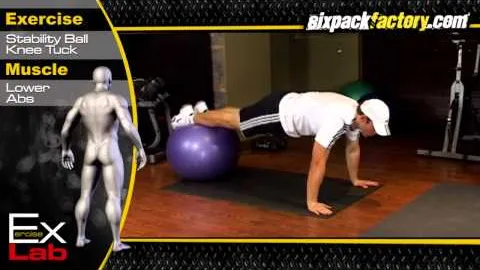
Stability Ball Knee Tuck Exercise - Strengthening Your Core and Lower Body
Are you looking for an effective exercise to strengthen your core and lower body? Look no further than the Stability Ball Knee Tuck exercise. This challenging exercise not only works your abdominal muscles but also engages your hips, glutes, and legs, helping you develop a strong and stable foundation.
The Stability Ball Knee Tuck exercise is a dynamic core exercise that targets the rectus abdominis, often referred to as the "six-pack" muscles. In this exercise, you use a stability ball to perform a knee tuck motion, bringing your knees towards your chest while maintaining balance and stability on the ball. This exercise requires control and coordination while engaging multiple muscle groups, making it an excellent choice for individuals looking to improve their core strength.
To perform the Stability Ball Knee Tuck exercise, follow these steps:
Start by placing a stability ball on the floor and kneeling in front of it. Place your hands on the ground shoulder-width apart and positioning your shins on top of the stability ball.
Engage your core muscles by drawing your belly button towards your spine. This will help stabilize your body throughout the exercise.
Once you're in a stable position, engage your abdominal muscles and hips while simultaneously tucking your knees towards your chest. As you bring your knees in, focus on maintaining proper form and balance. Hold this position briefly before extending your legs back to the starting position.
Repeat the exercise for the desired number of repetitions, aiming for a controlled and smooth movement each time.
Incorporating Stability Ball Knee Tucks into your workout routine can offer numerous benefits:
1. Strengthens Core Muscles: The primary target of this exercise is the core muscles, including the rectus abdominis and deep abdominal muscles. Regular practice helps strengthen these muscles, leading to improved stability and balance.
2. Engages Lower Body Muscles: Along with the core muscles, the Stability Ball Knee Tuck exercise also engages the hip flexors, glutes, and quads. This exercise allows you to work multiple muscle groups simultaneously, making it an efficient choice for those short on time.
3. Enhances Stability and Balance: Balancing on the stability ball while performing knee tucks challenges your stability and balance. As you progress with this exercise, your body learns to adapt and develop better proprioception, leading to improved coordination and balance in everyday activities.
4. Improves Posture: The Stability Ball Knee Tuck exercise requires you to engage your core muscles, promoting better posture. Strong core muscles can provide support for your spine, reducing the risk of poor posture-related issues such as lower back pain.
To perform the Stability Ball Knee Tuck exercise safely and effectively, keep the following tips in mind:
1. Start Slowly: If you're new to stability ball exercises, begin with a smaller range of motion and gradually increase the difficulty as you gain strength and stability.
2. Maintain Proper Form: Throughout the exercise, maintain a neutral spine and avoid rounding your lower back. Engage your core muscles and focus on keeping your body aligned from head to toe.
3. Breathe: Remember to breathe throughout the exercise. Exhale as you tuck your knees towards your chest and inhale as you extend your legs.
4. Use a Properly Sized Stability Ball: Ensure that you're using a stability ball that is the appropriate size for your height. Using the correct size will help you maintain balance and perform the exercise safely.
Adding Stability Ball Knee Tucks to your workout routine can provide variety and challenge your muscles in new ways. Depending on your fitness level and goals, you can incorporate this exercise in different ways:
1. Standalone Exercise: Perform Stability Ball Knee Tucks as a standalone exercise, aiming for 2-3 sets of 10-12 repetitions. Rest for 30-60 seconds between sets.
2. Circuit Training: Include Stability Ball Knee Tucks as part of a circuit training routine, combining them with other core and lower body exercises. Alternate between exercises and perform 3-4 rounds with minimal rest between exercises.
3. Superset with Upper Body Exercises: Pair Stability Ball Knee Tucks with upper body exercises, such as push-ups or dumbbell rows. Perform a set of upper body exercise followed by a set of knee tucks, alternating between upper and lower body exercises for a complete full-body workout.
The Stability Ball Knee Tuck exercise is a versatile and effective way to strengthen your core and lower body muscles. By incorporating this exercise into your routine, you can improve core stability, enhance balance, and develop a strong foundation for overall fitness. Remember to start slowly, maintain proper form, and make it a consistent part of your routine to reap the full benefits of this exercise. So, grab a stability ball and get ready to challenge your core muscles with the Stability Ball Knee Tuck exercise!
If you're looking for a gym, fitness club or yoga studio, you've come to the right place.
You can find information about gyms in your area. Browse catalog of gyms and find gyms with classes which are you looking for.
On gym page you can find simple information like address, phone or website. You can find list of available classes. You can check availability of personal training or small group classes. On place page you can also see information about open hours.
You can find gyms near you with amenities, courts, studios and equipments.
Use our map to find gym at your city or district.
In Gym Navigator you can find list of exercises with movies for many body parts.
You can browse exercises catalog and find exercises the best of you.
You can also find exercises grouped into workout plans, which you can use to improve you body. Each routine show you exercises one by one and give you possibility to count you progress and count down rest time.